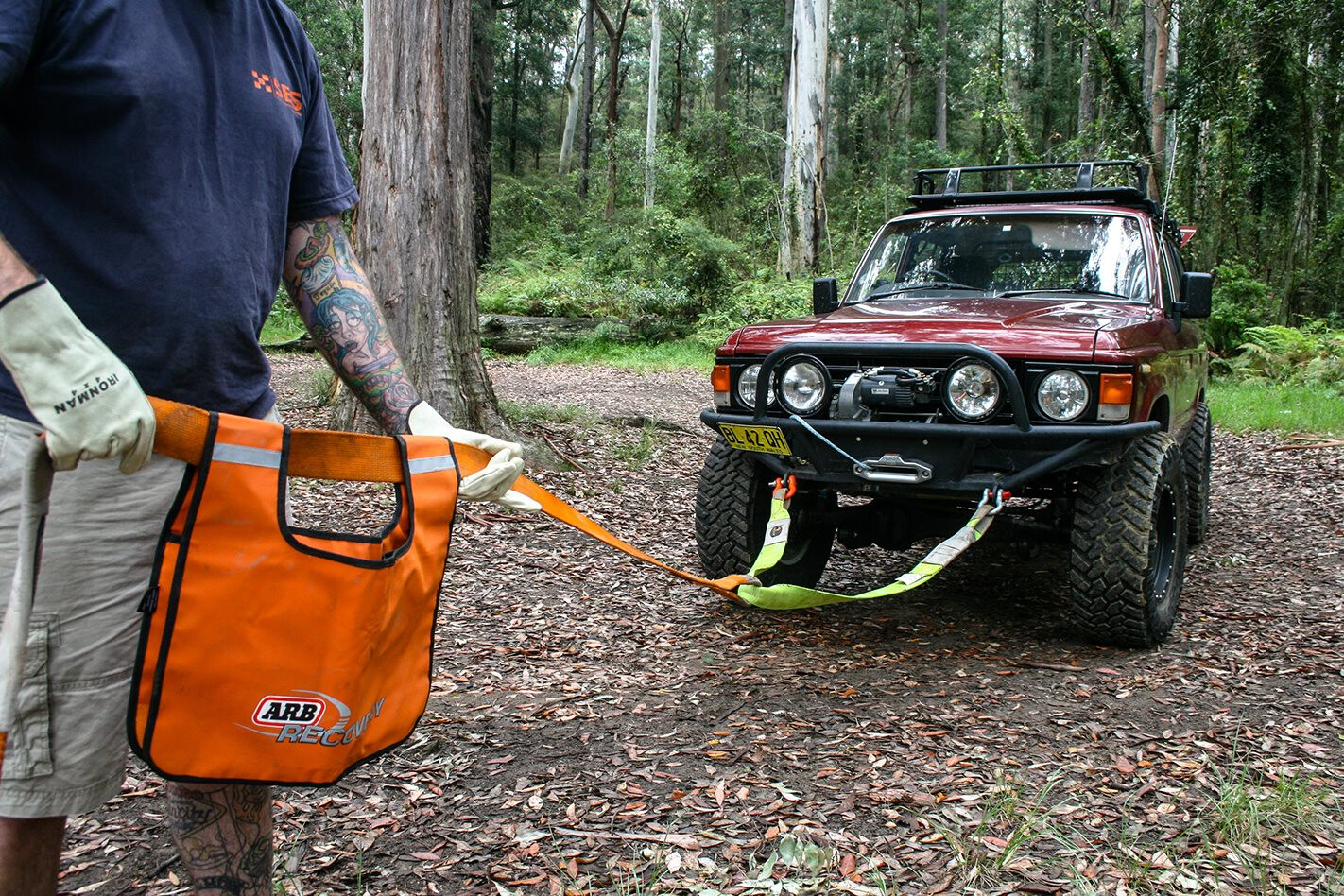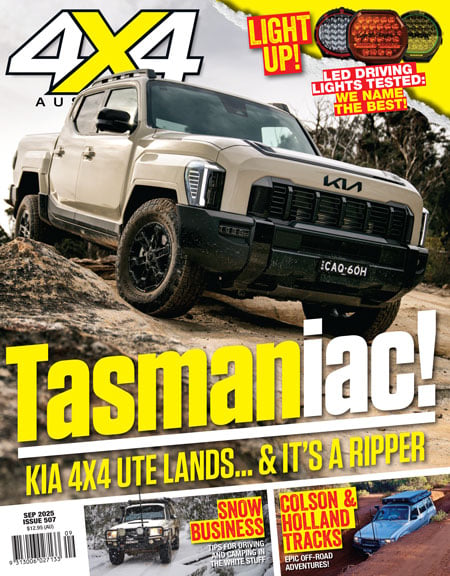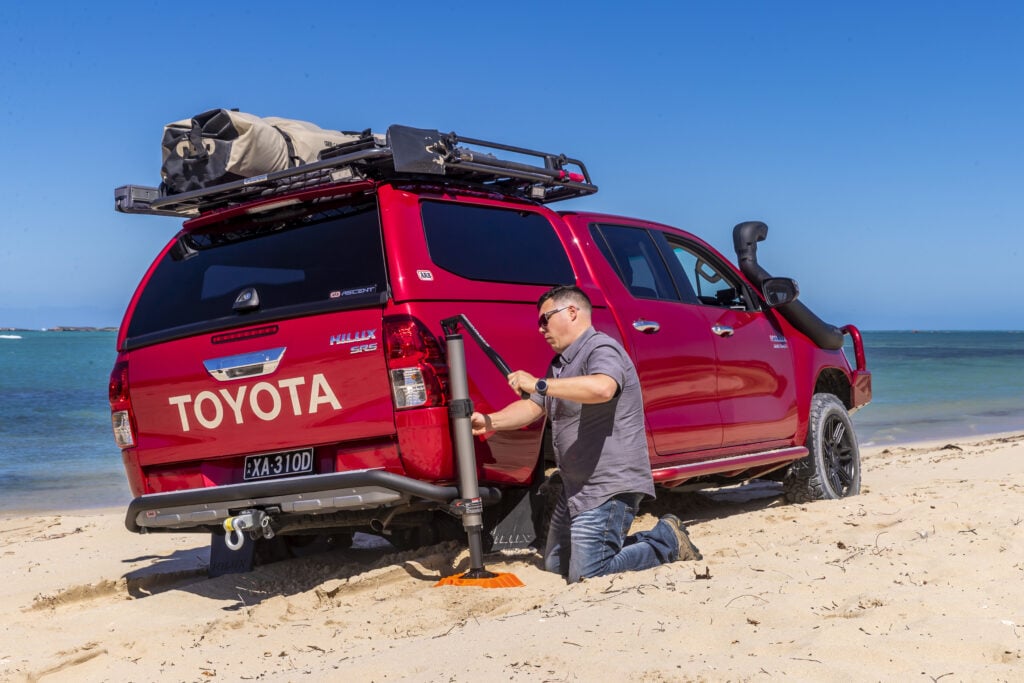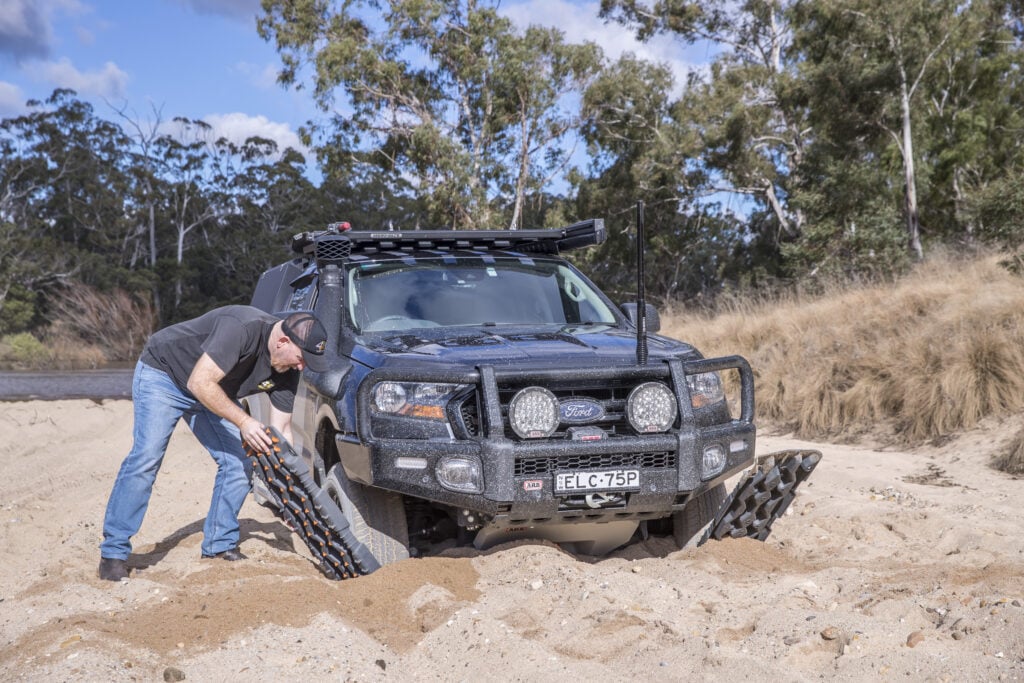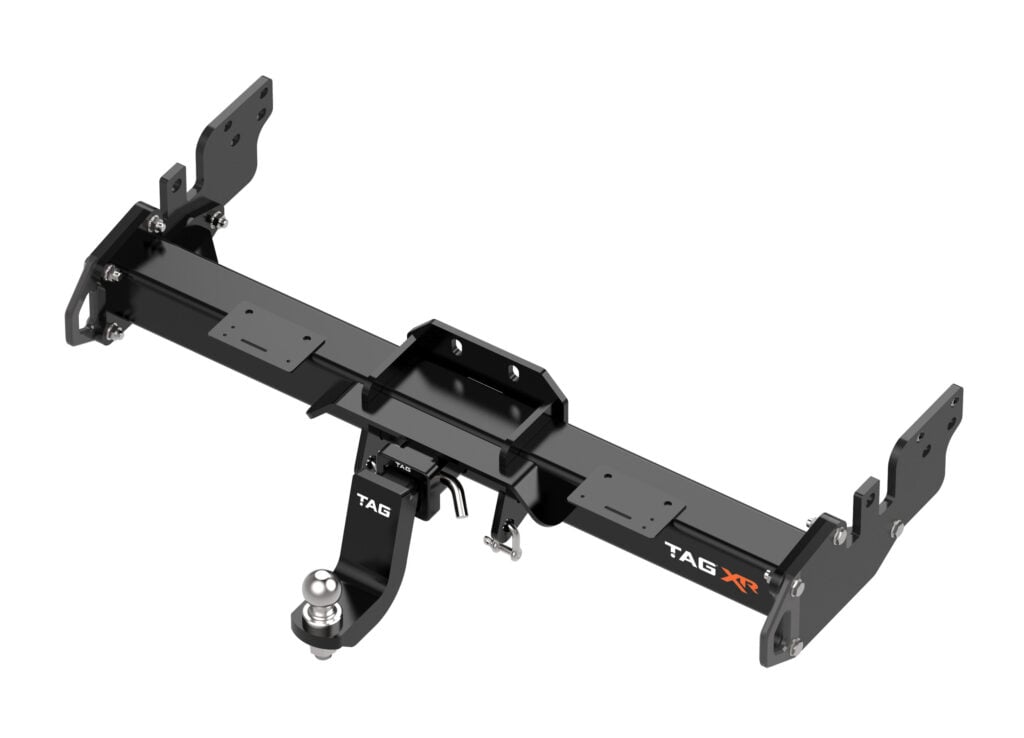NO-ONE wants to get stuck when exploring a new track or heading to a remote campsite, but this is inevitable for four-wheel drivers.
Your best friends in such a situation – additional recovery vehicle aside – are going to be a winch, the always-packed snatch strap and shackles, plus your rated recovery points on which you’ll attach the strap or winch cable.
These, as Adam Craze from Ironman 4×4 explained, are a non-negotiable must-fit accessory: “If a person is planning on going off-road and touring, we believe rated recovery points play an important part of a vehicle build.
They provide a safer connection point for all forms of winching or snatch recoveries. If they (the owners) are planning on using the vehicle in four-wheel drive, they should have recovery points.”
Simple, eh? Well, it should be, but note the mention of ‘rated recovery points’. For most 4x4s – as in, nearly all new models and a surprising number of ‘older’ or ‘traditional’ vehicles – this will mean you’ve actually had an aftermarket rated recovery point (or points; two is far better than one) fitted, rather than trying to use either the tow/transport hooks or the towball.
LOOKS DECEIVING
SO, WHAT about those tie-down/transport hooks? Well, they’re attachment points used to secure a static vehicle for transport (to the dealership, for example). These points aren’t subject to the incredible forces and load a recovery point has to cope with in a recovery situation, where a vehicle’s weight is working against both the snatch strap and the vehicle attached to that strap.
In short, it is incredibly unsafe – and stupid – to use them in recovery situations. Tie-down hooks will bend or break very quickly under any heavy load, leading to a catastrophic failure that could see your shackle transform from a vehicle saviour into an airborne missile that’ll effectively slingshot from its attachment.
The other corker is the use of a towball to hitch a recovery rope/strap to. As you’d expect, this is also a short road to disaster, with the ball incapable of coping with the force exerted by the kinetic energy involved in a recovery situation.
A rated recovery point, designed specifically to withstand the forces generated during this procedure, is the only way to ensure optimum safety, as ARB’s Steve Sampson explained.
“In terms of the OE tie-down points, they’ve been designed to secure a vehicle when it’s being shipped/transported from Thailand/Japan or wherever it has been manufactured through to Australia,” he said. “So they haven’t had any sort of rating for, say, any sort of additional load which may be placed on them – like if they were to be placed under some sort of snatch recovery or a winch load.
“So the difference between that and a rated recovery point is the rated recovery point has been designed, tested and developed so it can sustain any sort of additional load if it was having any sort of snatch recovery or winch load placed onto it.”
The lack of knowledge around safe recovery procedures and the confusion from owners regarding whether they can use tie-down/transport hooks and/or the towball is, according to Adam Craze, still a legitimate concern – a result, in part, due to the continuing boom in new 4×4 sales.
“I would say that most (4×4 owners) do not understand that tie-down points are not to be used for any style of recoveries,” Adam told us. “It is just like towballs; they should not be used. As the market expands, so does the need for awareness of this potential problem.
The 4WD vehicle market is expanding with a lot of first-time 4×4 owners who want to use their vehicles off-road and they all need to know how to uses their vehicle and recovery equipment safely.”
Adam added that he (along with 4X4 Australia) highly recommends joining a 4×4 club and/or doing a 4WD course that includes safe recovery techniques and education on the equipment needed to perform them.
THE POINT OF IT ALL
IT’S important to note when talking about ‘rating’ a recovery point that those numbers on which the rating is based are often for a best-case scenario (i.e. a perfectly straight line-pull during recovery).
Even then, the obstacle your vehicle is stuck in/on can add less or more force and load to the recovery points, strap and shackle involved in pulling you out – as well as the vehicle’s chassis – increasing the number of variables that influence the load amount on a recovery point.
Plus, you need to take into account the angle of the recovery – for example, ARB designs its recovery points to be rated for load at maximum wheel-turn angle.
The ARB recovery point is one part of a unique system designed to safely handle and transfer force into the chassis experienced during a recovery event, effectively protecting against potential chassis/vehicle damage.
Steve Sampson explained: “It is of no benefit having a recovery point with a high rating that fails to adequately distribute the force into the chassis in a manner that does not compromise the structural integrity of the OEM chassis system. The worst thing you want is for the recovery point to handle all loads/forces experienced in a recovery and yet damage or compromise the OEM chassis it is fitted to.”
Of course, aftermarket recovery point manufacturers take the variations on load angles into account when designing the products, and, remember, these things are built to do just one task: ensure a recovery is as safe and efficient as possible.
The design process also takes into account all the implements used in a recovery situation, with the idea to push any potential fail-point on to the least destructive component of the recovery procedure – the snatch-strap, rope or cable.
“Essentially, we’ve come up with a system which we call the ‘Recovery Train’, so we want to make sure that the weak point … is not the recovery point,” said ARB’s Sampson. “Generally, what you’re going to have is the recovery point, and you’ll have a shackle, and you’ll have a snatch-strap attached to the other vehicle.
We want to ensure the weak point within that is the snatch strap, so all of our recovery points have been designed to work with a 4.7-tonne rated shackle and then an 8-tonne-rated snatch strap, so the weak point is always going to be the snatch strap.
“The 4.7-tonne shackle will generally have a safe working load of five or six times, so it takes it up to 24- to 26-tonne. We would much rather – if something was to go wrong – the strap would be the part that would break, rather than having a big chunk of metal flying through the air, which has been ripped off the vehicle.”
It’s common to see off-road vehicles fitted with two recovery points at the front end. Two points aren’t essential, but if you can fit two to your rig (not all vehicles can be fitted), we’d recommend it.
The reason for this is to get around the potential problem of a single point being inaccessible – one side might be deep in mud/broken/stuck under something. A choice of two points allows you to take best advantage of where the recovery vehicle is and at what angle it’s positioned, allowing for the ‘straightest’ line-pull possible.
Two recovery points mean you can use an equalising strap – often called a bridle strap – which allows you to connect the two points at a junction to the main recovery line. This effectively halves the load each point has to take up and distributes the load/force across a wider area, which may minimise any chassis twist or damage.
This method works best when tackling a straight-line recovery, because once you’re recovering on an angle, the load distribution – or share – across the two recovery points is altered, with one under more load than the other. Also take into account that the equalising strap is being loaded from its ‘side’ rather than in a straight line from its end, which may affect the effective load rating of the strap.
“If you were to use some sort of bridle strap – if it’s made out of some sort of plasma or Dyneema-style rope – the load rating on that rope is generally done on a straight-line pull,” Steve Sampson said. “So if you’re using that as a bridle strap, the load point actually then becomes as a side pull on that particular rope.
“Realistically, when you’re stuck in mud or whatever, it’s pretty rare that you’ll have a 100 per cent dead-straight pull, so the load would be very hard to distribute half-and-half on those two points.”
A rear recovery is often needed to extract a vehicle, but when it comes to a rear recovery point the best (often only) recovery point available is the towbar hitch (not the towball).
Adam Craze explained: “Although we normally concentrate on designing front recovery points, a rear recovery point is just as important. In most cases a (rated) recovery hitch in a towbar is a safe and acceptable point to use. A towball is not ever – never ever – acceptable to use as a recovery point.”
In terms of rated rear recovery hitches, Adam explained the rating must always come from the lowest rated part involved – in the case of an Ironman 4×4 rear recovery, a hitch rating of 4.75-tonne (as opposed to the company’s minimum 5-tonne rating for a front recovery point). This also applies to front recovery points and all the implements involved.
WHY WOULDN’T YOU?
THE recovery point is a relatively basic accessory when it comes to fitment and maintenance, despite the huge amount of engineering and design time involved. This takes into account a vehicle’s chassis strength, maintaining the load rating even at maximum angle of recovery (usually based on the maximum wheel angle of the vehicle), air-bag compliance, and its near-bombproof build (plate steel and high-tensile bolts).
This doesn’t mean you just fit and leave it, as the recovery point, like all fitted accessories, needs to be regularly checked to ensure it’s still correctly fitted and there’s no sign of fatigue or damage.
The relatively straightforward fitment process and ease of maintenance, tied in with the simple fact they’re an essential for anyone considering venturing off-road, means there is really no reason not to fit rated recovery points to your vehicle … and there are way too many reasons why you should.
SAFE AND SOUND
SAFETY during a recovery – snatch or winch – is paramount, so it’s essential to have the correct gear and follow certain safety procedures during the process. This starts in your garage, by checking recovery points for any damage or loose fittings. Next, ensure your recovery kit (strap, shackles, gloves, etc.) is packed in your rig and all contents are serviceable.
When it’s time to initiate the recovery, ensure you can access the recovery point safely and easily. Check the wheels are on firm ground, and under no circumstances should you crawl under a vehicle bogged in soft mud. Move everyone out of the way of the area and ensure they stay to the side, as should anything break and fly off it will generally do so in the direction of the recovery.
When attaching the snatch strap or winch cable, connect it to your recovery point via a rated shackle and don’t overtighten the shackle. Instead, wind it right up and then back it off a quarter-turn to avoid it seizing when under load and thus making it impossible to remove.
The most common shackles are metal-rated shackles, but for those looking to eliminate the slight chance of a rated shackle breaking and sending dangerous pieces of flying metal through the air, you can opt to use a rated soft shackle.
The Roadsafe soft shackle is made from 10mm 12-strand synthetic rope (similar to synthetic winch rope), hence the ‘soft’ moniker, and is rated to a ‘rope splice’ breaking load of nine tonnes (similar rope tech is used in yachting, but with less loading involved).
It includes a loop at one end and a large knot at the other, with ‘bracing’ sections of the shackle colour-coded to line up with your recovery point and snatch strap.
We asked Troy Schipper, 4WD Product Development Manager at Roadsafe, exactly how the soft shackle works. “The soft shackle utilises tension to set the knot,” he said. “Setting up the shackle requires the shackle to be positioned so the load is across the shackle and not directly on the knot. Once load is applied in a recovery situation, the tension applied to the loop at the base of the knot will hold its shape.”
Troy also reiterated the advice of Adam and Steve regarding maintenance and regularly inspecting the shackle (and the rest of your recovery gear) to ensure it’s all in working condition and set-up correctly during recovery.
Finally, once set-up, don’t forget to throw a damper (recovery blanket, for example) over the snatch strap/winch cable before recovery.
Communication between the two vehicles involved is the last essential step to a successful recovery, and it’s especially pertinent during a snatch recovery. The driver in the bogged vehicle needs to know when the snatch is about to take place so they can (if possible) accelerate to assist in the pull.
Plus, an agreed stop point must be communicated between the vehicles to save additional load/strain on the vehicles and recovery components.
THE POWER OF FORCE
SO, HOW much force and load is involved in a vehicle recovery? Well, that’s a very difficult question to answer due to the nature of recovery situations.
Each recovery situation is unique and will contain a number of variables: the weight of both the bogged/stuck vehicle and the recovery vehicle; the substance the vehicle is stuck in (mud will add much more suction force to the recovery compared to sand); whether either vehicle is on an incline/decline; and whether the tyres on the bogged vehicle are inflated and/or are at any particular angle.
Adam Craze added: “As Newton states, the force is equal to the weight, multiplied by acceleration”, with all of these affected by the above.
Having said that, controlled tests have been conducted that measured force in a particular recovery situation. One such test was undertaken by the late, highly regarded 4×4 journalist Ian Glover, in conjunction with Mitsubishi Motors Australia Limited (MMAL), to test/check for any potential distortion in the then-current Pajero’s monocoque chassis during a recovery.
This test involved using a stock Pajero stuck in relatively soft, shallow sand (just under the sill). The 4×4 was subjected to a straight-line pull snatch recovery on level ground and then a recovery on an incline.
The MMAL engineers used a load meter to record the load in kilonewtons (kN) through the snatch strap via a ‘strain gauge’ (attached to a plate metal block on the meter that stretched under load) to a laptop on-board the vehicle.
The load recorded for a straight-on (no angle) recovery on a flat surface was 2.06-tonne (20.6Kn) – an ‘ideal scenario’ in terms of a snatch recovery.
The second recovery was undertaken with the Pajero bogged on a short incline (less sand depth than the level location, but the wheels again pointed straight-on), and the recovery vehicle snatched the bogged Paj forward and over the incline.
The figure recorded in this scenario was 3.16 tonne (31.6Kn), showing how factors such as gravity/incline influence load on the recovery points, shackles and the snatch strap. This also explains the high load rating figures on aftermarket recovery points, snatch straps and shackles – and why you should fit and use them.

